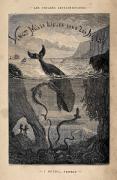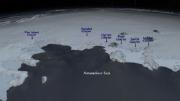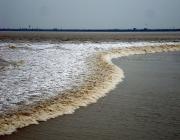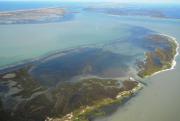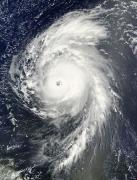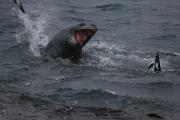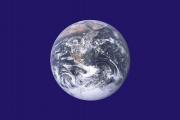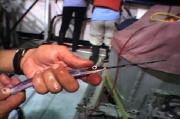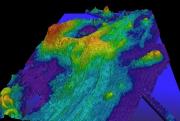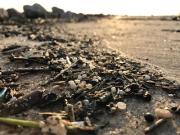Radio Program
Our regular Science and the SeaTM radio program presents marine science topics in an engaging two-minute story format. Our script writers gather ideas for the radio program from the University of Texas Marine Science Institute's researchers and from our very popular college class, Introduction to Oceanography, which we teach to hundreds of non-science majors at The University of Texas at Austin every year. Our radio programs are distributed at to commercial and public radio stations across the country.
In June of 1870, readers in France were treated to the conclusion of one of the most exciting adventure stories of the century. It was the end of an underwater odyssey – the travels of Captain Nemo and his guests aboard the submarine Nautilus. It’s an adventure that’s been inspiring marine scientists, engineers, and others ever since.
The effects of our changing climate extend from main street to the ends of the Earth. Warmer air and oceans are melting the ice cap at the north pole, for example. And a recent study says the same thing is happening in the Antarctic.
In recent decades, the West Antarctic Ice Sheet has been melting at an increasing pace. It contains about six million cubic miles of ice. But glaciers on its edge are getting smaller. Scientists have suspected that global climate change is playing a role. But natural changes in the Pacific Ocean also change the rate at which the glaciers melt.
Surfers who want to spend a long time riding a single wave might not want to spend their time in Hawaii, Australia, or Portugal. Instead, they might want to surf up a river in China, where a single wave can last for more than an hour -- a wave known locally as the silver dragon.
When a hurricane heads ashore, everything in its path is in danger. But not everything suffers the same fate. One house may be blown away, while the one next door suffers little damage. And the same thing happens off shore. Some seagrass beds may be wiped out, for example, while others are left pretty much unscathed.
Researchers at the University of Texas Marine Science Institute studied what happened to seagrass beds when Hurricane Harvey roared ashore in Texas, in 2017.
When Hurricane Bill spun along the coast of New England in August of 2009, the ocean floor rumbled. It continued to rumble for 30 hours. The motion was detected more than 2500 miles away. And it packed as much punch as a magnitude-3.5 earthquake.
Stormquakes jiggle the ocean floor all the time -- but only in some areas. They’re powered by both hurricanes and winter storms, such as the nor’-easters that barrel off the coast of New England. Yet they were discovered only recently.
Leopard seals are dangerous loners. They can be 10 feet long and weigh half a ton, and they sometimes attack people -- they’ve killed at least one.
Yet they’ve also been known to offer penguins to divers. Some have seen the gesture as a friendly gift, or perhaps as an act of pity for a poor hunter. But British researchers recently came up with another possible explanation: The seal might be trying to get the diver to share a meal -- an act that would make it easier for the seal to consume its dinner.
By the late 1960s, many Americans were getting fed up with bad news about the environment. A book early in the decade warned about the dangers of pesticides. An oil spill on the coast of California killed thousands of birds and other creatures. A river in Ohio caught fire. And pictures snapped by Apollo astronauts showed Earth as a fragile blue ball.
To inform Americans about the problems, Senator Gaylord Nelson of Wisconsin organized an “environmental sit-in.” It was held on April 22nd of 1970 -- the first Earth Day. And an estimated 20 million people took part.
A fish known as the halfbeak looks like it’s about ready to do some knitting, have a sword fight, or give somebody an injection. That’s because its lower jaw resembles a needle -- it’s long, thin, and pointed. But the halfbeak doesn’t appear to use it to “jab” anything at all.
There are about 70 species of halfbeaks. They’re found in the open ocean or in coastal waters around the world. Most are no more than a few inches long, with sleek silvery bodies. They live near the surface, so they’re darker on top than the bottom -- a bit of camouflage from both predators and prey.
The busiest volcano in the Pacific Northwest isn’t Mount Rainier, Mount Hood, or even Mount St. Helens. Instead, it’s a peak that’s 300 miles off the Oregon coast, almost a mile beneath the surface of the Pacific Ocean.
Axial Seamount belongs to a chain of submarine volcanoes that stretches from Oregon to near Alaska. They’ve built up along the boundaries between slabs of Earth’s crust. Axial, for example, is on the fault between the Juan de Fuca Plate and the Pacific Plate. Magma pushes up along the boundary, building underwater volcanoes.
A “nurdle” sounds like a character from a children’s TV show. And if you look at one, it seems just about as harmless. But these tiny plastic beads can cause big problems for marine life.
“Nurdle” is a nickname for plastic pellets that are no more than five millimeters across -- the thickness of a stack of three U.S. quarters. The pellets are the raw materials for making larger plastic items, from toothbrushes to cellphone cases to car parts.

